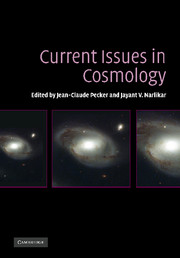Book contents
- Frontmatter
- Contents
- List of contributors
- Preface
- Part I Observational facts relating to discrete sources
- Part II Observational facts relating to background radiation
- Part III Standard cosmology
- Part IV Large-scale structure
- 9 Observations of large-scale structure
- 10 Reconstruction of large-scale peculiar velocity fields
- Part V Alternative cosmologies
- Part VI Evidence for anomalous redshifts
- Part VII Panel discussion
- Index
10 - Reconstruction of large-scale peculiar velocity fields
Published online by Cambridge University Press: 15 December 2009
- Frontmatter
- Contents
- List of contributors
- Preface
- Part I Observational facts relating to discrete sources
- Part II Observational facts relating to background radiation
- Part III Standard cosmology
- Part IV Large-scale structure
- 9 Observations of large-scale structure
- 10 Reconstruction of large-scale peculiar velocity fields
- Part V Alternative cosmologies
- Part VI Evidence for anomalous redshifts
- Part VII Panel discussion
- Index
Summary
Abstract
A reconstruction method for recovering the initial conditions of the Universe starting from the present galaxy distribution is presented, which guarantees uniqueness of solutions. We show how our method can be used to obtain the peculiar velocities of a large number of galaxies, hence trace galaxies' orbits back in time and obtain the entire past dynamical history of the Universe above scales where multi-streaming has not occurred. When tested against a 1283 ΔCDM simulation in a box of 200 h–1 Mpc length, we obtain 60% exact reconstruction on scales above 6 h–1Mpc. We apply our method to a real galaxy redshift catalog, the updated NBG (Nearby Galaxies), containing 1 483 groups, and clusters in a radius of 30 Mpc h–1, and reconstruct the peculiar velocity fields in the local neighborhood. Our reconstructed distances are well matched to the observed values outside the collapsed regions if Ωm(t) = 0.20 exp(–0.26(t – 13)), where t is the age of the Universe in Gyrs.
Introduction
Reconstruction of the initial condition of the Universe from the present distribution of the galaxies, brought to us by ever-more sophisticated redshift surveys, is an instance of the general class of inverse problems in physics. In cosmology this problem is frequently tackled in an empirical way by a forward approach. A statistical comparison between the outcome of an N-body simulation and the observational data is made, assuming that a suitable bias relation exists between the distribution of galaxies and that of dark matter.
- Type
- Chapter
- Information
- Current Issues in Cosmology , pp. 123 - 136Publisher: Cambridge University PressPrint publication year: 2006
- 1
- Cited by



